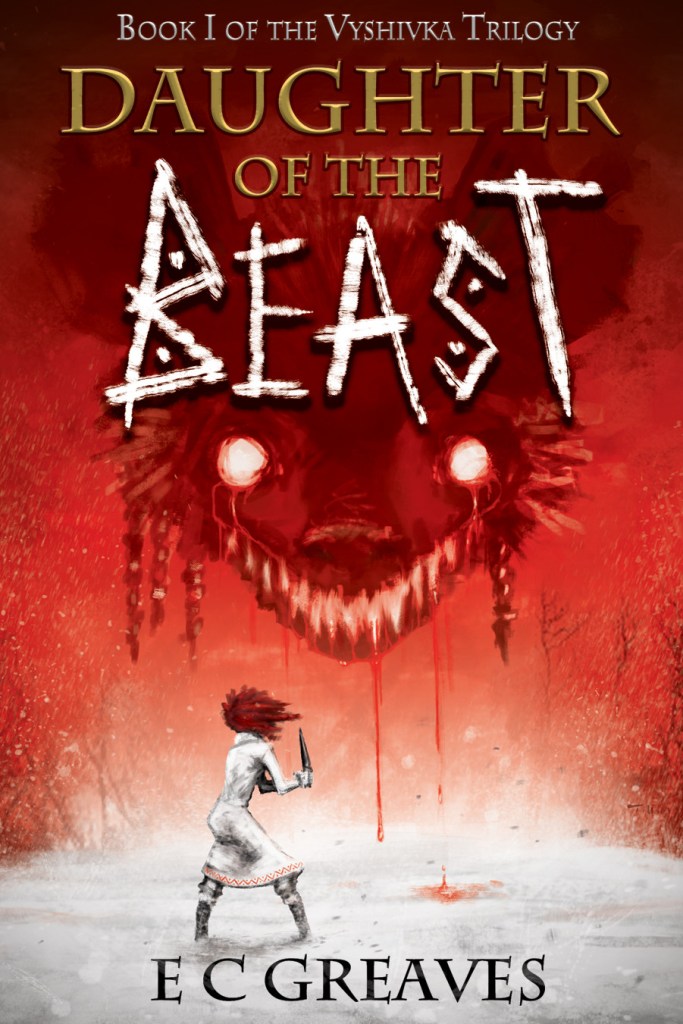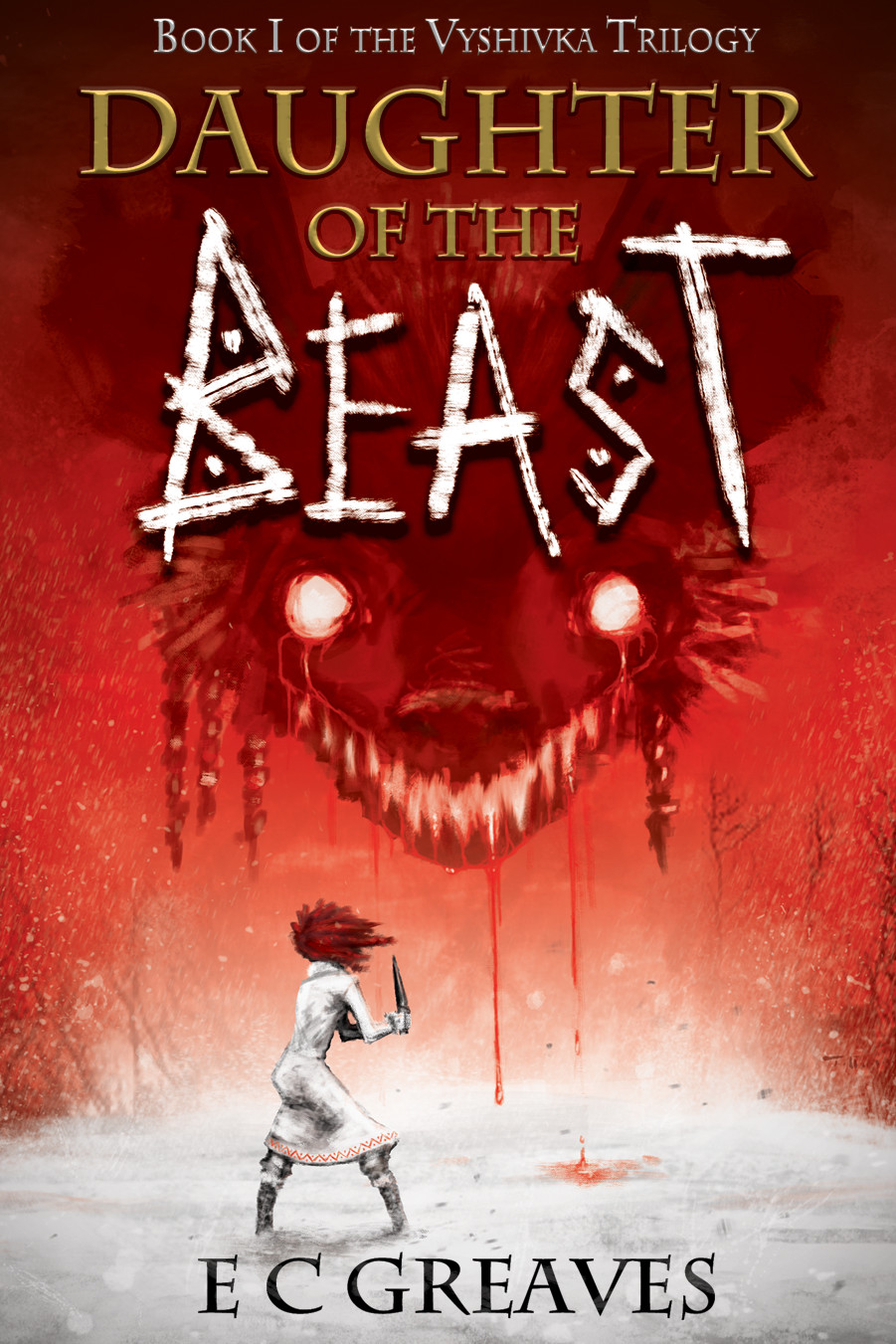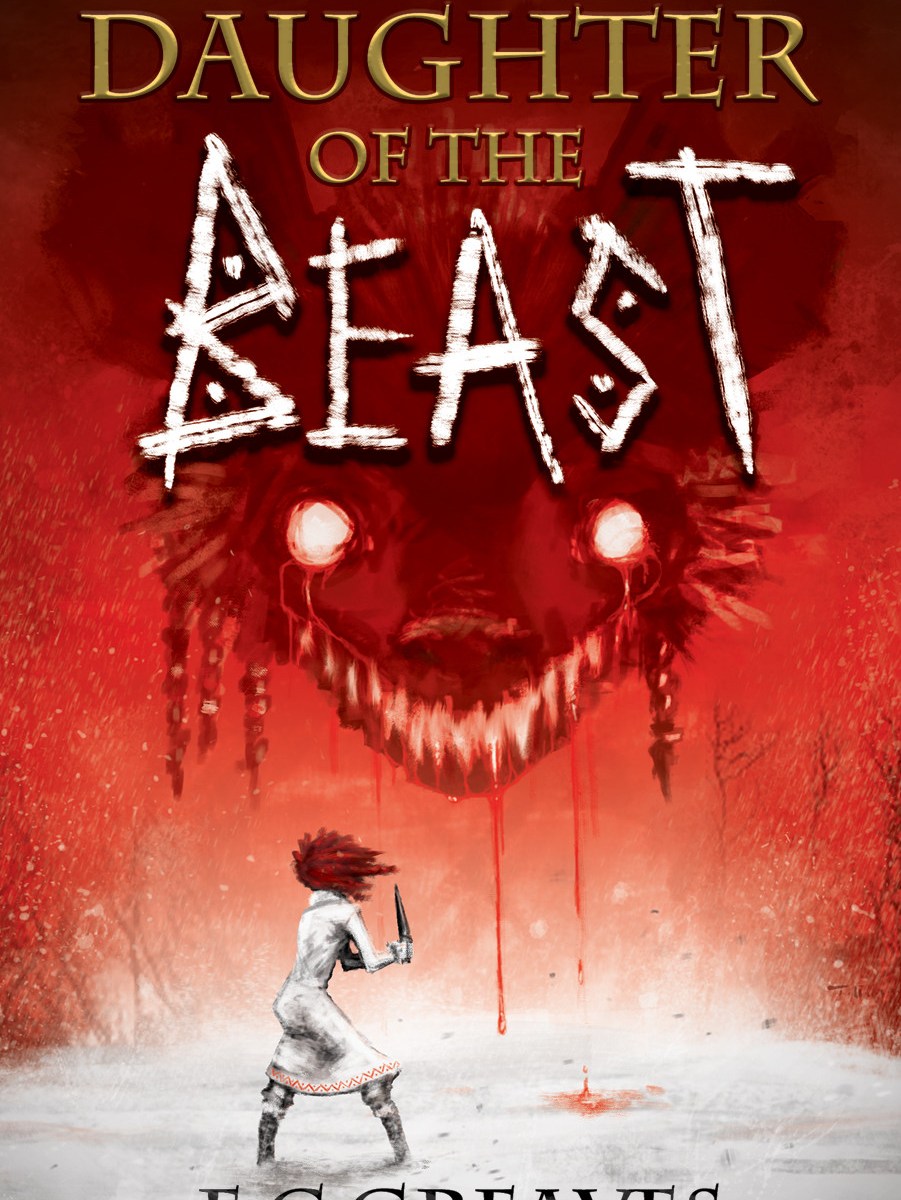

Written by EC Greaves
Those of you who follow these reviews would well know that I’m a fan of mythology. And further, that I’m particularly a fan of books that weave elements of these myths into their narratives. There are a number of mythologies I’m not particularly well-versed in, and one of these is Slavic mythology… outside of what The Witcher has taught me, that is. So when the opportunity to review EC Greaves’ Daughter of the Beast came up, I leapt at the chance to review a novel that draws heavily from Slavic myth. And it soon became apparent that Daughter of the Beast is not The Witcher. It’s something else entirely, and entirely unexpected.
While I try not to make a habit of discussing a book’s cover (they’re a great draw for readers, but it’s what’s on the inside pages that counts), a close look at Daughter of the Beast’s cover hints at what’s to come (go ahead, click the image above to zoom in. The ghoulish image of a monster—a Vulkari, as readers learn inside the book—blood dripping onto the snow below, hints that the novel is a dark fantasy. Yet, the young girl, seen from behind, is presented with a painterly quality. Juxtaposed with the Vulkari, it captures a sense of wonder and beauty. Daughter of the Beast is indeed a dark fantasy, yet it is filled with beauty. Upon opening the book, before starting the story, the reader is treated to an amusing old gnome proverb. Yes, this book has a great sense of humour that helps blend its dark and beautiful elements.
Although squarely a fantasy, and an epic fantasy at that, it is difficult to think of Daughter of the Beast in such terms, and to do so would sell it short. Fans of fantasy and Slavic mythology will find much to love, and the book presents these elements in a unique light. The fantastical elements are wonderful, and yet, they only form a part of the book, almost feeling like background details compared to everything else.
The book’s Amazon listing mentions that Daughter of the Beast will appeal to adult and young adult readers alike. While I’d caution against younger young adult fans reading the book thanks to some adult-without-the-young content, it is packed with the genre’s hallmarks. The protagonist is a young girl, it tells a coming of age story, it’s packed full of adventure, it revolves around a found family, and throws some romance in for good measure. These elements all sing while capturing the feeling of what it is to be young. Through its protagonist’s first person narration, the reader can’t help but connect with her and see the world through her eyes.
This connection is made all the more wonderful in that the protagonist—the wonderfully named Zyntael Fairweather—isn’t human. She’s a Kimora (more formally, a Kikimora, derived from the house spirit of Slavic myth). Not a single character in Daughter of the Beast is human, but every character exudes humanity, both for better and worse. As the blurb says, the Vulkari are monsters, and the Kimoras are justified in their fear of them. However, their culture has a nobility of its own, which is beautifully explored through its characters. All of them feel as though they have their own histories and stories to tell. As the sole point of view character, Zyntael forms the heart of the story. Aged between eleven and sixteen-years-old through the course of the book, she always comes across as her age—sometimes to great humour, and leading to a great recurring joke—without ever feeling too precocious. As the character ages, so does her maturity, which coalesces wonderfully with the world she’s thrust into. This is a dark story that leads her to dark places, but never at the expense of her relatability.
At 381 pages in paperback or hardcover (or an estimated 467 pages on Kindle), Daughter of the Beast is broken into six parts, or “stitches.” These segregate the story nicely and work with the flow of Zyntael’s arc. The story progresses at a quick pace, particularly given the years it stretches, but it is never rushed. Instead, the story takes the time to put the world on display and luxuriate in the world’s beauty.
That the book does this so magnificently is a testament to Greaves’ writing. The novel’s prose is written with absolute precision. Throughout the book, the sentences flow together immaculately. They paint a beautiful picture of the book’s world and inhabitants; they capture the horror of the story’s events; they display the magic’s majesty; and they offer a wry sense of humour throughout. Most impressively, throughout the book, they are beautiful. If you don’t care for fantasy tales or young adult stories, the words will draw you in and captivate you. The dialogue complements the prose perfectly. All the characters have their own unique voice—some more unique than others—that helps make the world feel like a living, breathing place, filled with living, breathing characters.
Although the first book in the Vyshivka Trilogy, Daughter of the Beast stands alone in its own right. It tells a coming of age story that feels complete. While the book ends with a young character who presumably has many years ahead of her, with more adventures to come, it closes on a note that feels complete. That there are two more books (Sister of the Dead and Mother of the Bond) is a mere promise of more stories set in the world.
Daughter of the Beast is many things: an epic dark fantasy, a coming of age story, a glimpse at Slavic mythology. Most of all, however, it is beautiful. This beauty extends to the story, the world, its characters, and its writing. It’s an affecting experience that will remain with you long after you have finished with the book. And it’s an experience I am looking forward to exploring further with the rest of the trilogy as soon as humanly possible.
Favourite Passage
If Mazgar truly was going to shit herself during the raid, now would be the perfect time.
It was terrifying.
My senses were overwhelmed; by the cacophony of the melee and the ceaseless shrill ringing of a warning bell, by the billowing, noxious smoke that surrounded and choked me, and by the sprawling chaos that had erupted in the village square.
Daughter of the Beast: Book I of the Vyshivka Trilogy, “The Third Stitch – Transformation,” ix
Daughter of the Beast: Book I of the Vyshivka Trilogy was provided by the author for the purpose of an honest review.
Daughter of the Beast is available in paperback, hardcover, and on Kindle, exclusive to Amazon.
Note: I do not post scores for reviews on this website, but do post them on my Amazon and Goodreads reviews:
- Amazon
- Goodreads
You can follow EC Greaves online, via:

Interested in purchasing Daughter of the Beast?
Please find a link below; please note I do not collect any proceeds from the sale.
Daughter of the Beast (The Vyshivka Trilogy Book 1)

